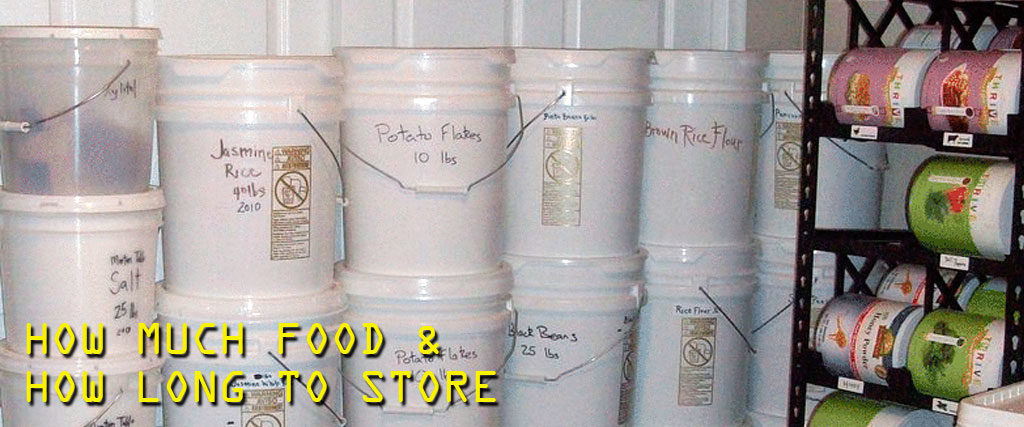How Much Food & How Long to Store
Some of the most common questions regarding food storage are how much should I store, and how long can I store it for? This blog post should help in answering these questions.
Here are some suggestions for items within each of these categories that you can use. You can divide up the yearly amount for each major category among the different types of foods within that category according to what fits your family.
It’s important to store your food at a room temperature of 75 degrees Fahrenheit or less, with as little humidity as possible if you can.
The following are suggested amounts to store per person unless stated otherwise, per year
Grains: 300 lbs
Legumes: 60 lbs
Powdered Milk: 16 lbs
Cooking Oil: 25 lbs
Sugar or Honey: 60 lbs
Salt: 8 lbs
Fruits: 185 lbs (per family)
Vegetables: 185 lbs (per family)
Cooking Essentials: 8 lbs
Meats/Meat Substitutes 20 lbs
When storing food for more than a year, the aim is to get the oxygen out of the food to the greatest extent possible. This will not only kill any microorganisms, but will also keep the food from going rancid.
There are a few ways you can do it on your own. First, you can use oxygen absorbers, but the trick is you have to use them correctly and in the right size to be sure you get out as much oxygen as you can.
For a #10 can (about the size of a paint can), you need a 300cc – 500cc absorber, depending on whether there will be a lot of air space in the food. For a 5 or 6 gallon bucket, you’ll need a 1000cc – 2000cc absorber depending on what you’re storing. If there is more air in the bucket, like when you store pasta, then you should use the higher absorber. For grains, you can use the lower. It helps if you use mylar bags to put the grain or pasta in first, and add the oxygen absorber(s). You can use two 500 cc absorbers for pasta, for example, placing one half way up in the food and then the second one near the top. Then seal the bag and store with an airtight lid.
The second way people can store food long term themselves is to use nitrogen. You replace the oxygen in the container/bag with nitrogen. However, you would need to be sure you had the proper equipment and got enough oxygen out.
The third way is to use dry ice. I don’t think as many people use this method as much these days as perhaps in the past.
Quite frankly, in my opinion, the easiest thing to do is to buy it from a food storage company, or to use oxygen absorbers if doing it yourself. Why make it harder than it has to be?
Grains: Be sure to package your foods so that rodents and bugs can’t get it.
Approximate Shelf Life (stored in optimum conditions such as airtight buckets):**
Amaranth 20 years
Barley 8 years
Cereal 2-3 years
Cornmeal 25 years
Flour 5 years
Millett 20 years
Mixes – pancake, muffin, bread 2 years
Oats 25 years
Pasta 8 years
Quinoa 20 years
Rice (white) 30 years
Wheat 30 years
Legumes/Beans (Dried):
Black Beans 30 years
Kidney Beans 25 years
Lentils 30 years
Lima Beans 30 years
Pinto Beans 25 years
White Navy Beans 30 years
Milk/ Dairy:
Cheese (freeze dried) 20 years
Evaporated Milk 2 years
Non-fat Powdered Milk 25 years
Sweetened Condensed Milk 2 years
Yogurt (freeze dried) 25 years
Sugar:
Brown Sugar 10 years
Corn Syrup 2 years
Honey (real not manufactured) Indefinitely
Jams/Jellies 2 years
Jello 18 months
Maple Syrup 2 years
Molasses 2 years
Powdered Sugar (bags) 2 years
30 years in airtight bucket
Pudding 18 months
White Granulated Sugar 30 years in airtight bucket
Oils/Fats:
Butter 1 year in freezer
5 years if butter powder
Cooking oil 1-2 years
Margarine 1 year in freezer
Mayonnaise 1-2 years
Olive Oil 1-2 years
Peanut Butter 1 year
5 – 6 years if dehydrated powder
Salad dressing 1 year
Shortening 3-5 years in unopened can
10 years if powder
Fruits and Vegetables – most fruits and vegetables that are freeze dried will last for 25 years.
Meat – most meat that is freeze dried will last for 25 years
Cooking Essentials:
Baking Powder 3 years
30 years if in airtight bucket
Baking Soda 3 years
30 years in airtight bucket
Cocoa 3 years
Eggs 3 years if powdered
Vanilla 3 years
Vinegar 2 years +
Yeast 1 year in freezer
Don’t forget to add condiments and spices to your supplies. Most condiments will last about 2 years in a cool, dry place. And dried spices are good for at least 3 years if kept dry and bug-free.
Start with your favorites and add a bit each month.
Happy Prepping!

